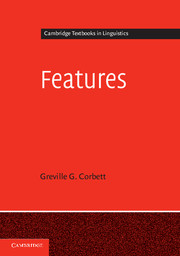Book contents
- Frontmatter
- Contents
- Figures
- Tables
- Preface
- Abbreviations
- 1 Why features?
- 2 Formal perspectives
- 3 Features for different components
- 4 Justifying particular features and their values
- 5 Typology
- 6 Canonical Typology and features
- 7 Determining feature values
- 8 Feature-value mismatches
- 9 Conclusions
- Appendix Standards and implementations
- References
- Author index
- Language index
- Subject index
- References
6 - Canonical Typology and features
Published online by Cambridge University Press: 05 November 2012
- Frontmatter
- Contents
- Figures
- Tables
- Preface
- Abbreviations
- 1 Why features?
- 2 Formal perspectives
- 3 Features for different components
- 4 Justifying particular features and their values
- 5 Typology
- 6 Canonical Typology and features
- 7 Determining feature values
- 8 Feature-value mismatches
- 9 Conclusions
- Appendix Standards and implementations
- References
- Author index
- Language index
- Subject index
- References
Summary
When we analyse feature systems in detail, particularly when using the approach described in §4.1.2, we find some surprises. We discover systems whose main outline is clear, yet which also have some remarkable characteristics. Several of these have been catalogued and labelled. Typically these interesting phenomena are described feature by feature. If we take a more abstract view, we can discern regular patterns in the apparent oddities. I therefore suggest a canonical approach (§6.1) and lay out a canonical scheme for morphosyntactic features, using morphological criteria first (§6.2). This allows us to calibrate the phenomena which lie outside the core of feature systems. We find that indeed the same types of non-canonical behaviour are found with different features, though they may be given rather different names in the literature (§6.3). We evaluate these results in §6.4. Then we consider the syntactic principles for canonical features in §6.5 and review canonical inflection in §6.6.
The canonical approach in typology
Imagine we found a language in which every last noun had robust morphology distinguishing singular and plural, and every verb, adjective and adposition showed clear agreement in number. We would propose a morphosyntactic feature number, with the values singular and plural, without hesitation. Any alternative would make the syntax highly redundant (rather like what we saw in §1.1.1). On the other hand, if we found a language in which the only trace of number was a distinction between the equivalent of ‘I’ and ‘we’, then an argument for a number feature would need skilful support. Of course, many languages fall between these two extremes. Yet we are perhaps too ready to treat them as though they were instances of the first type. Morphosyntactic features, like number, often have a ‘penumbra’ where the data are not clear-cut, and we need to be careful in our analysis.
- Type
- Chapter
- Information
- Features , pp. 153 - 199Publisher: Cambridge University PressPrint publication year: 2012

